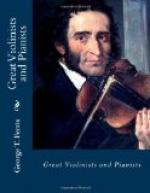Veracini played upon a fine Steiner violin. The only master he ever had was his uncle Antonio, of Florence; and it was by traveling all over Europe, and by numerous performances in public, that he formed a style of playing peculiar to himself, very similar to what occurred to Pa-ganini and the celebrated De Beriot in later years. It does not appear certain that Tartini ever took lessons from Veracini; but hearing the latter play in public had no doubt a very great effect upon him, and caused him to devote many years to the careful study of his instrument. Some say that Veracini’s performance awakened a vivid emulation in Tartini, who was already acknowledged to be a very masterly player. Up to the time, however, that Tartini first heard Veracini, he had never attempted any of the more intricate and difficult feats of violin-playing, as effected by the management of the bow. An intimate friendship sprang up between the two artists and another clever musician named Marcello, and they devoted much time to the study of the principles of violin-playing, particularly to style and the varied kinds of bowing. Veracini’s mind afterward gave way, and Tartini withdrew himself to Ancona, where in utter solitude he applied himself to working out the fundamental principles of the bow in the technique of the violin—principles which no succeeding violinist has improved or altered. Tartini, even while absorbed in music, did not neglect the study of science and mathematics, of which he was passionately fond, and in the pursuit of which he might have made a name not less than his reputation as a musician. It was at this time that Tartini made a very curious discovery, known as the phenomenon of the third sound, which created some sensation




